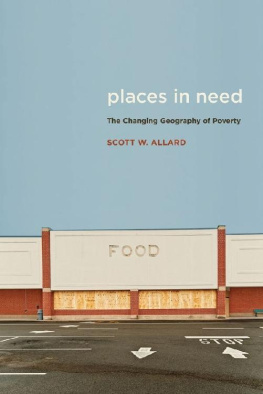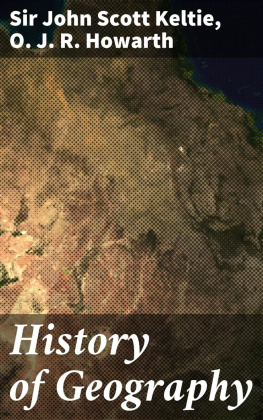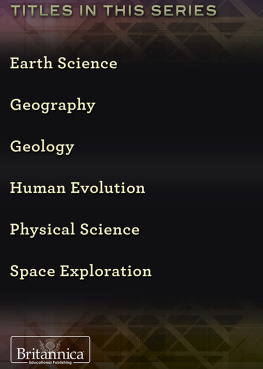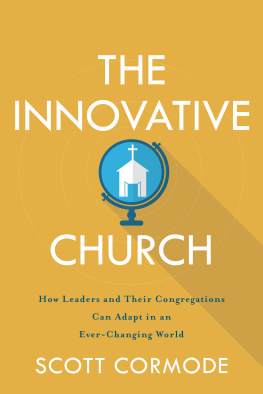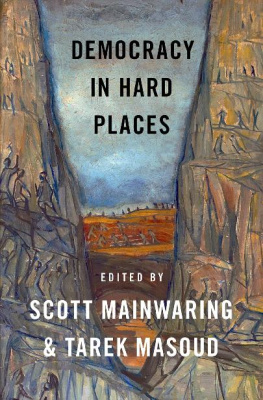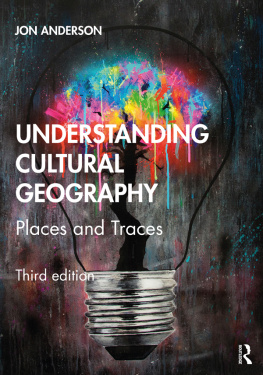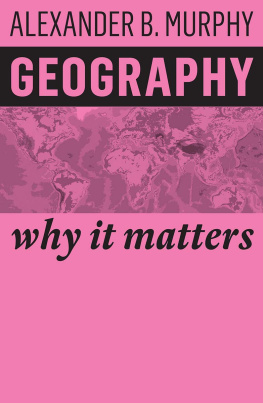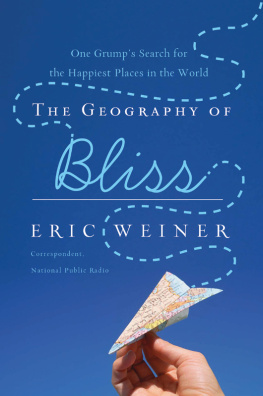Scott W Allard - Places in Need: The Changing Geography of Poverty
Here you can read online Scott W Allard - Places in Need: The Changing Geography of Poverty full text of the book (entire story) in english for free. Download pdf and epub, get meaning, cover and reviews about this ebook. year: 2017, publisher: Russell Sage Foundation, genre: Business. Description of the work, (preface) as well as reviews are available. Best literature library LitArk.com created for fans of good reading and offers a wide selection of genres:
Romance novel
Science fiction
Adventure
Detective
Science
History
Home and family
Prose
Art
Politics
Computer
Non-fiction
Religion
Business
Children
Humor
Choose a favorite category and find really read worthwhile books. Enjoy immersion in the world of imagination, feel the emotions of the characters or learn something new for yourself, make an fascinating discovery.
- Book:Places in Need: The Changing Geography of Poverty
- Author:
- Publisher:Russell Sage Foundation
- Genre:
- Year:2017
- Rating:4 / 5
- Favourites:Add to favourites
- Your mark:
- 80
- 1
- 2
- 3
- 4
- 5
Places in Need: The Changing Geography of Poverty: summary, description and annotation
We offer to read an annotation, description, summary or preface (depends on what the author of the book "Places in Need: The Changing Geography of Poverty" wrote himself). If you haven't found the necessary information about the book — write in the comments, we will try to find it.
Places in Need: The Changing Geography of Poverty — read online for free the complete book (whole text) full work
Below is the text of the book, divided by pages. System saving the place of the last page read, allows you to conveniently read the book "Places in Need: The Changing Geography of Poverty" online for free, without having to search again every time where you left off. Put a bookmark, and you can go to the page where you finished reading at any time.
Font size:
Interval:
Bookmark:
THE CHANGING GEOGRAPHY OF POVERTY
Scott W. Allard
Russell Sage Foundation
NEW YORK
THE RUSSELL SAGE FOUNDATION
The Russell Sage Foundation, one of the oldest of Americas general purpose foundations, was established in 1907 by Mrs. Margaret Olivia Sage for the improvement of social and living conditions in the United States. The foundation seeks to fulfill this mandate by fostering the development and dissemination of knowledge about the countrys political, social, and economic problems. While the foundation endeavors to assure the accuracy and objectivity of each book it publishes, the conclusions and interpretations in Russell Sage Foundation publications are those of the authors and not of the foundation, its trustees, or its staff. Publication by Russell Sage, therefore, does not imply foundation endorsement.

LIBRARY OF CONGRESS CATALOGING-IN-PUBLICATION DATA
Names: Allard, Scott W., author.
Title: Places in need : the changing geography of poverty / Scott W. Allard.
Description: New York : Russell Sage Foundation, [2017] | Includes bibliographical references and index. | Description based on print version record and CIP data provided by publisher; resource not viewed.
Identifiers: LCCN 2016052524 (print) | LCCN 2017011615 (ebook) | ISBN 9781610448659 (ebook) | ISBN 9780871545190 (pbk. : alk. paper)
Subjects: LCSH: PovertyUnited States. | Population geographyUnited States.
Classification: LCC HC110.P6 (ebook) | LCC HC110.P6 A675 2017 (print) | DDC 362.50973dc23
LC record available at https://lccn.loc.gov/2016052524
Copyright 2017 by Russell Sage Foundation. All rights reserved. Printed in the United States of America. No part of this publication may be reproduced, stored in a retrieval system, or transmitted in any form or by any means, electronic, mechanical, photocopying, recording, or otherwise, without the prior written permission of the publisher. Reproduction by the United States Government in whole or in part is permitted for any purpose.
The paper used in this publication meets the minimum requirements of American National Standard for Information SciencesPermanence of Paper for Printed Library Materials. ANSI Z39.48-1992.
Text design by Matthew T. Avery.
RUSSELL SAGE FOUNDATION
112 East 64th Street
New York, NY 10065
For my son, August William Allard-Hill
To the hope and work that will make our communities
better places for all people
Figures
Tables
SCOTT W. ALLARD is professor at the Evans School of Public Policy and Governance at the University of Washington.
My childhood in the 1970s and 80s was spent in the Diamond Lake neighborhood of Minneapolis, the southernmost neighborhood in the city. During most of those years, my family rented a two-bedroom duplex on a busy through street largely composed of similar rental units for young adults, single parents, and retirees. The side streets were a mix of modest-sized prewar starter homes on small lots. Homes were nicer in some tucked-away areas, a bit more basic in others. The neighborhood was predominantly white and middle-class, with relatively little residential turnover. It had a few basic amenities: a couple of gas stations, a drugstore, an ice cream shop, a hardware store, and a small chain supermarket. The most exciting features of this sleepy neighborhood were a record store and a fish-and-chips restaurant owned by a Minnesota North Stars hockey player.
Immediately bordering my neighborhood to the south was the suburb of Richfield. The local historical society touts Richfield as Proudly Suburban Since 1854. South Minneapolis and Richfield are separated by Minnesota State Highway 62, built in the 1960s and locally known as the Crosstown freeway. Apart from driving over a bridge spanning the Crosstown, it could be difficult to know when you had left Diamond Lake and entered Richfield. As in all municipalities in the Twin Cities metropolitan area at that time, there was a large green sign on a main local thoroughfare stating that you had entered Richfield and providing you with the most recent decennial census population count. The housing stock was built roughly at the same time as Diamond Lakes and shared many of the same features. Richfield too was a predominantlywhite, middle-class community. Street signs and sidewalks were only negligibly different from Diamond Lakes. Both communities shared the ignominious distinction of being immediately underneath the landing flight path for much of the air traffic into MinneapolisSt. Paul International Airport. Planes flew over Diamond Lake and Richfield so close to the ground that most children growing up there in the 1970s would remember seeing the heads of passengers in the windows of noisy DC-10s roaring over the treetops of local parks.
Yet there were differences between Diamond Lake and Richfield that might not have caught the casual eye. Richfield was zoned like a suburb, with postwar ranch homes on large lots. Big-box stores and fast-food restaurants populated several strip malls. My family did most of its shopping at the Hub, which was the largest shopping center in the Twin Cities when it opened in 1954. Richfield offered the typical teenager many more employment opportunities than Diamond Lake. In high school, I took a minimum-wage job as a dishwasher at a hamburger grill in Richfield patterned after the TV show Happy Days. Richfields school system did not appear to have budget and class size problems comparable to those in my South Minneapolis schools. As an adolescent, I was acutely aware that Richfields high school sports teams were better than those of the local Minneapolis public high schoolsparticularly in hockey, the first sport of Minnesotans. Richfields hockey history was rich with future college, Olympic, and professional hockey players.
About ten years ago, my brother and his wife began to look for a house back in our old neighborhood. After much searching, they decided to buy a house in Richfield instead, just across the Crosstown Freeway from our childhood home. Property values in Richfield were more affordable. Now, when I visit my brother, I can see the somewhat divergent socioeconomic paths the two communities have taken. Diamond Lakes increasing appeal to higher-income families and professionals has pushed up house prices. My old neighborhood grocery store has been rebranded as a high-end retailer. A sushi restaurantunthinkable in the 1970s and 1980sis a popular local dining spot. The community association calls Diamond Lake a hidden jewel in the city.
Meanwhile, after the population growth of the 1960s and early 1970s, Richfields population fell by about 25 percent, and median real-dollarincome has stayed flat since I was in high school. My old hamburger grill is now a tanning salon with a payday loan business next door. Facing diminished student interest in the sport, Richfield High School has closed its hockey program. Richfield is now home, however, to one of the best taquerias in the Upper Midwesta reflection of its growing Mexican American community. I go for lunch or dinner every time I visit home.
Around the same time my brother and sister-in-law bought their house in Richfield, I was finishing the initial manuscript for my first book, Out of Reach: Place, Poverty, and the New American Welfare State, which was about the spatial mismatches between low-income neighborhoods in cities and the social service organizations that help the poor. The book was based on telephone surveys with nearly 1,500 social service organizations in Chicago, Los Angeles, and Washington, D.C., and I decided that it would be wise to visit some of the organizations that had participated. One of my goals was to continue to hone my feel for the context in which these organizations were operating. These visits ensured that my interpretations and analysis reflected the local story and experience.
Font size:
Interval:
Bookmark:
Similar books «Places in Need: The Changing Geography of Poverty»
Look at similar books to Places in Need: The Changing Geography of Poverty. We have selected literature similar in name and meaning in the hope of providing readers with more options to find new, interesting, not yet read works.
Discussion, reviews of the book Places in Need: The Changing Geography of Poverty and just readers' own opinions. Leave your comments, write what you think about the work, its meaning or the main characters. Specify what exactly you liked and what you didn't like, and why you think so.

